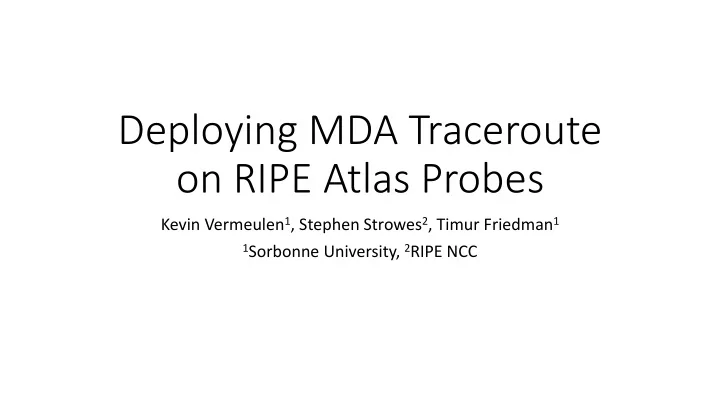

Deploying MDA Traceroute on RIPE Atlas Probes Kevin Vermeulen 1 , Stephen Strowes 2 , Timur Friedman 1 1 Sorbonne University, 2 RIPE NCC
Summary • Multipath Detection Algorithm (MDA) and its limits • Towards a better MDA: • Survey on load balancers • Provide heuristics based on data • Results
Multipath Detection Algorithm: Definition • Allows to discover all the paths between a source and a destination, based on paris-traceroute • Statistical guarantees on the discovered topology • Potentially sends tens of thousands of packets to discover all the topology • Makes the worst case hypothesis that every discovered interface could be part of a load balancer
Survey (work in progress) • 350,000 traceroutes towards destinations from IMPACT IP Hitlist • Work divided among 35 PlanetLab nodes as sources • 100,000 traceroutes computed at the moment (computing still in progress) • 40% of the traceroutes contained at least one diamond
Survey: diamond lengths max_length = min_length = 2
Survey: diamond widths max width = 4
Survey: width asymmetry width asymmetry = 2
Survey: meshed diamonds • 15.3 % are meshed diamond • More meshing metrics are being defined in our ongoing work
The MDA uses 8500 packets to discover this topology! Source : ple2.planet-lab.eu Destination : 125.155.82.17
MDA overhead: packets sent • hop 1: one node discovered • Is there a second node? • Send n2 = 8 packets to hop 1 • No more nodes found • hop 2: six nodes discovered • Is there a seventh node? • Send n7 = 43 packets • No more nodes found • hop 3: each hop 2 node is a potential branching point! • Must find n2 = 8 flows that go to each hop 2 interface • Send all 6x8 = 48 packets to hop 3 • Only 1 node found • Can we do better? Measured topology Ground truth
Towards a better MDA • hop 1 : n2 = 8 • hop 2 : n7 = 43 • hop 3 : n2 = 8 • Assumption: equal probability to reach any of the interfaces at hop 3 • We make this assumption because our survey reveals that most diamonds are symmetric Measured topology Ground truth
Towards a better MDA • For each combination of these characterictics: symmetry, asymmetry, meshed, not meshed -> We provide heuristics to save probes
New vs Classic MDA on a length 1 diamond 40% of packets are needed to discover all the vertices 60% of packets are needed to discover all the edges
New vs Classic MDA on a longer symmetric diamond 50% of packets are needed to discover all the vertices 60% of packets are needed to discover all the edges
New vs Classic MDA on a meshed diamond 20% of packets are needed to discover all the vertices 60% of packets are needed to discover all the edges
New vs Classic MDA on an asymmetric diamond 40% of packets are needed to discover all the vertices 80% of packets are needed to discover all the edges
References • 1 https://paris-traceroute.net/images/infocom2009.pdf • 2 https://ant.isi.edu/datasets/all.html • 3 http://mat.uab.cat/matmat/PDFv2014/v2014n02.pdf
Questions?
Recommend
More recommend